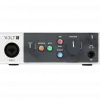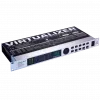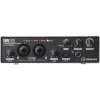
The cables terminate in a 180° five-pin DIN connector. Standard applications use only three of the five conductors: a ground wire, and a balanced pair of conductors that carry a +5 volt signal. This connector configuration can only carry messages in one direction, so a second cable is necessary for two-way communication. Some proprietary applications, such as phantom-powered footswitch controllers, use the spare pins for direct current (DC) power transmission.
Opto-isolators keep MIDI devices electrically separated from their connectors, which prevents the occurrence of ground loops and protects equipment from voltage spikes. There is no error detection capability in MIDI, so the maximum cable length is set at 15 meters (50 feet) in order to limit interference.
Most devices do not copy messages from their input to their output port. A third type of port, the "thru" port, emits a copy of everything received at the input port, allowing data to be forwarded to another instrument in a "daisy chain" arrangement. Not all devices contain thru ports, and devices that lack the ability to generate MIDI data, such as effects units and sound modules, may not include out ports.


![Focusrite Scarlett 8i6 [3rd Gen] USB Driver](/sites/default/files/styles/thumbnail/public/2023-12/sound-focusrite-scarlett-8i6.webp?itok=RIghiUXK)


